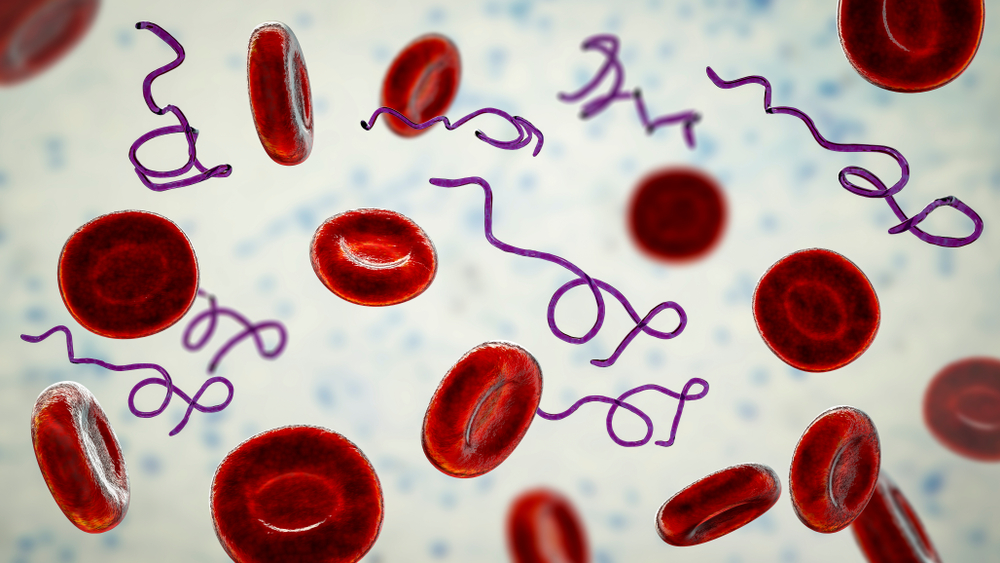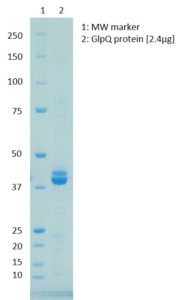SDS-PAGE: Coomassie-stained SDS-PAGE showing purified B. miyamotoi GlpQ protein.
Borrelia Miyamotoi GlpQ Protein, His-Tag
Price range: $763.05 through $2,900.83 excl. VAT
This is a recombinant Borrelia miyamotoi GlpQ protein produced in E. coli with
BORRELIA MIYAMOTOI GLPQ PROTEIN, HIS-TAG
This is a recombinant Borrelia miyamotoi GlpQ protein produced in E. coli with
PRODUCT DETAILS – BORRELIA MIYAMOTOI GLPQ PROTEIN, HIS-TAG
- Recombinant full length Borrelia miyamotoi GlpQ protein (NCBI: WP_025443886.1).
- Protein produced in E. coli cells with C-terminal 10x His-tag.
- Purified using immobilised metal affinity chromatography and ion exchange chromatography to >90% purity.
- Presented in 300 mM NaCl, 50 mM Tris-HCl, pH 8.5.
BACKGROUND
Relapsing Fever is an arthropod-borne infection caused by bacteria of the genus Borrelia, and sub-species Relapsing Fever. It can be divided into Louse-borne Relapsing Fever and Tick-borne Relapsing Fever. Borrelia miyamotoi is a tick-borne relapsing fever Borrelia group spirochete that is transmitted by the same hard-bodied (Ixodid) tick species that transmit the agents of Lyme disease. It was discovered in 1994 in Ixodes persulcatus ticks in Japan. B. miyamotoi species phylogenetically cluster with the relapsing fever group spirochetes, which usually are transmitted by soft-bodied (argasid) ticks or lice. B. miyamotoi infects at least six Ixodes tick species in North America and Eurasia that transmit Lyme disease group spirochetes and may use small rodents and birds as reservoirs. Human cases of B. miyamotoi infection were first reported in 2011 in Russia and subsequently in the United States, Europe and Japan (Krause et al., 2015). The most common clinical manifestations of B. miyamotoi infection are fever, fatigue, headache, chills, myalgia, arthralgia, and nausea. Symptoms of B. miyamotoi infection generally resolve within a week of the start of antibiotic therapy. As early as 1985, spirochetes that were likely B. miyamotoi were observed in ticks in the United States. However, they were mistakenly thought to be B. burgdorferi as a consequence of cross-reactive antibodies that were used in direct immunoassays. Additionally, antigenic cross-reactivities in immunoassays between Borrelia species in North America also complicated diagnosis of both Lyme disease and relapsing fever (Magnarelli et al., 1987).
In 1996, Schwan et al. reported the identification of an immunodominant enzyme in Borrelia hermsii called glycerophosphodiester phosphodiesterase (GlpQ, GDPD). Eight species of relapsing fever group spirochetes were found to contain a GlpQ ortholog and six Lyme disease Borrelia species did not (Schwan et al., 2003). Sera from Lyme disease patients should not cross-react in a GlpQ assay because Lyme disease Borrelia species (as well as Anaplasma, Babesia and Ehrlichia species) lack the gene for GlpQ (Schwan et al., 1996). Indeed, serum from humans infected with relapsing fever group spirochetes reacted positively by immunoblotting with Borrelia miyamotoi GlpQ protein, while serum from patients with Lyme disease did not (Schwan et al., 1996). As such, serologic testing is now used to help confirm B. miyamotoi diagnosis. An antibody response to Borrelia GlpQ antigen is a characteristic of relapsing fever that distinguishes it from the immune response to Lyme disease (Schwan et al., 1996). A two-tiered antibody assay based on recombinant B. miyamotoi GlpQ protein was developed that detects GlpQ-specific antibodies during the acute and convalescent stages of infection (Schwan et al., 1996). B. miyamotoi GlpQ protein is also no more than 50% identical to the GlpQ proteins of some other bacterial pathogens, such as Klebsiella pneumoniae and Salmonella enterica and so is not expected to cross-react with anti-GlpQ antibodies elicited by other disease agents (Bacon et al., 2004).
REFERENCES
- Bacon et al. (2004). Glycerophosphodiester Phosphodiesterase Gene (glpQ) of Borrelia lonestari Identified as a Target for Differentiating Borrelia Species Associated with Hard Ticks (Acari:Ixodidae). J Clin Microbiol. 42(5): 2326–2328.
- Schwan et al. (1996). GlpQ: an antigen for serological discrimination between relapsing fever and Lyme borreliosis. J Clin Microbiol. 1996 Oct; 34(10):2483-92.
- Schwan et al. (2003). Glycerol-3-phosphate acquisition in spirochetes: distribution and biological activity of glycerophosphodiester phosphodiesterase (GlpQ) among Borrelia species. J Bacteriol. 2003 Feb; 185(4):1346-56.
- Krause et al. (2015). Borrelia Miyamotoi Infection in Nature and in Humans. Clinical Microbiology and Infection. Volume 21, Issue 7, Pages 631-639.
- Magnarelli et al. (1987). Cross-reactivity in serologic tests for Lyme disease and other spirochetal infections. J Infect Dis, 156, pp. 183-188.


